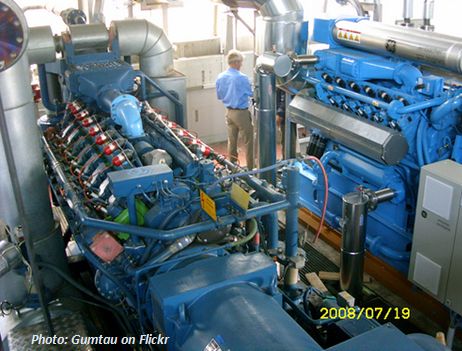A biogas heating system using boiler technology is the obvious on-site choice for anyone running a biogas plant, and these can either:
– make use of a Combined Heat and Power System (CHP) Heat Exchanger utilizing the jacket heat otherwise wasted from a reciprocating gas-generator, or
– use biogas produced on-site, or delivered from a biogas plant, to create hot water for space heating by burning part or all of the biogas created by an anaerobic digestion plant.
Using biogas for heating requires investment in new infrastructure. However, UK installations can benefit from the Renewable Heat Incentive (RHI) support. The RHI includes support for biogas combustion and for biomethane injection into the national grid at all scales.
Don't Underestimate the Value of Using CHP!
Combined heat and power (CHP) is the simultaneous production of usable heat and electricity. As the process of AD requires some heat it is suited to CHP and this is currently the most popular option for UK plants.
The ratio of heat to power varies dependent on the scale and technology, but typically 35-40% is converted to electricity, 40-45% to heat and the balance lost as inefficiencies at various stages of the process.
We have written about CHP previously here, for all those considering a CHP heat sourced biogas heating system, so we won't discuss that further here. Instead we will concentrate on providing information on biogas heating systems using a biogas boiler.
Biogas Heating Systems Based on the Use of a Biogas Boiler

A biogas boiler is a great solution for thermal energy production
Biogas boilers are available to work seamlessly with existing Anaerobic digestion plants, from suppliers such as Shaw Renewables.
Requirements for a biogas boiler:
Capable of producing 85˚c – 95˚C hot water or pressurized steam for over 7,500 hours per annum – over 85% availability is possible.
– A boiler system tailored to the requirements of each site/ project.
– Capable of rapid repayment for costs invested capital returns, with (UK costs) under RHI support, within 12 months
– A remote monitoring and support package should be included
– Skid mounted or in an ISO Container.
Benefits of a Biogas Heating System
The heat output of biogas boilers can be tailored to the central heating project requirements.
A biogas boiler can be automated to utilise excess gas which can possibly avoid flaring off profitable biogas.
Better revenue – Receive quarterly payments through the RHI scheme. Businesses in the UK may be able to obtain RHI scheme assistance here [Look around their website for the information.] at shawrenewables.co.uk
The Chinese “Take” on Biogas Heating Systems
In rural areas of China, household-scaled biogas digester plays an important role in improving rural production and living conditions, impelling energy conservation and emission reduction, and thus protecting the environment.
To date, the household digester has become the largest biomass energy industry in China. However, when operating in the cold winter, a low slurry temperature of the digester often results in a relatively low efficiency or even a suspension in the fermentation process.
Similarly, in the biogas production from agriculture manure by anaerobic digestion, it is necessary to keep the bioreactor at an optimum and steady temperature.
The optimum condition usually can not be achieved automatically in winter in North China without an additional heat source. Solar water heating systems have provided the solution. They use evacuated tubes with an auxiliary electrical heater to supply thermal energy to the heat the bioreactor. This makes the bioreactor warm enough to work reliably at high output rates all through the winter.
A hybrid heating system which integrates the advantages of solar energy heating system and biogas boiler heating system, would also be a highly synergistic solution.
Results of recent test showed that, employing one such hybrid heating system, the slurry temperatures of the two heated digesters could be maintained around 19.82 °C and 23.50 °C, and the average production rate could be increased to 0.389 m3/(m3 d) and 0.472 m3/(m3 d).
Additionally, an economic and sensitivity analysis shows that yet the increased the initial and maintenance cost notwithstanding, the hybrid system benefits greatly from more net production of biogas during lifetime employment. via sciencedirect.com
Biogas CHP Heat Efficiency
High temperature exhaust gas heat can either be used directly into a drier, waste heat boiler or organic rankine cycle unit. Alternatively it can be converted into hot water using a shell and tube exhaust gas heat exchanger to supplement the heat from the engine cooling systems.
Waste heat boilers produce steam typically at 8-15bar. Driers may be useful to reduce the moisture content of the digestate to assist in reducing transportation costs. Organic rankine cycle turbines are able to convert surplus waste heat into additional electrical output.
In the event that the local legislation requires for the destruction of pathogens in the digestate (such as the European Animal By-Products Regulations) there may be the requirement to heat treat the waste via pasteurisation or sterilisation. Here, surplus heat from the gas engine can be used in the pasteurisation unit.
The heat from the CHP engine can also be used to drive an absorption chiller to give a source of cooling, converting the system to a trigeneration plant. via clarke-energy.com
Routes to Energy Production from Biogas Including Heating Systems
Biogas produced from anaerobic digestion of sewage, agricultural or municipal wastes or recovered from landfill can be:
a) used at the point of collection in gas engines or heating systems or
b) distributed to remote locations for use via purpose built distribution networks.
Alternatively it can be;
c) pressurised and bottled or
d) upgraded/partially upgraded and injected into existing natural gas mains (and thus mixed with natural gas). via organics-recycling.org.uk
Wikipedia on Biogas Heating
Biogas can be used as the fuel in the system of producing biogas from agricultural wastes and co-generating heat and electricity in a combined heat and power (CHP) plant. Unlike the other green energy such as wind and solar, the biogas can be quickly accessed on demand.
In Oakley, Kansas, an ethanol plant considered to be one of the largest biogas facilities in North America is using Integrated Manure Utilization System “IMUS” to produce heat for its biogas heating system by utilizing feedlot manure, municipal organics and ethanol plant waste.
Heat Exchangers for Heat Recovery
Cooling and recovering the heat from exhaust gases can increase the efficiency of combined heat and power (CHP) plants used to generate electricity using biogas. Using HRS G Series heat exchangers with corrugated tubes on the exhaust recovers energy which can be used elsewhere in the plant, including feedstock and digester heating, pasteurisation and digestate concentration.
The contents of the digester must be heated to maintain the ideal temperature for the bacteria to work. Pre-heating the feedstock before it enters the digester will minimise the amount of heat needed in the digester itself and will improve the overall efficiency of the process.
For such applications, HRS recommends DTI Series heat exchangers. Thanks to the corrugated tube in tube design, a high level of heat transfer is maintained, without the risk of obstruction or blockages associated with spiral heat exchangers, thus ensuring continuous operation in harsh environments.
A heat recovery step can be included as an option thus reducing energy costs up to 20%, cold gas at 5°C is used to precool the incoming gas at 40°C, whilst raising the temperature of the dehumidified gas to approximately 36°C before use. A chiller is included to provide the energy required for the process.
The BDS comes complete with controls in a packaged ‘plug and play' skid. via hrs-heatexchangers.com
Biogas Heating for Digester Tanks
Indirect heating is preferred over the direct heating method where hot water is injected into the rector to maintain a mesophilic or thermophilic temperature range in winter.
Direct heating is accomplished with heat exchangers located either inside or outside of the digester, depending on the shape of the vessel, the type of substrate used, and the nature of the operating mode.
The high cost is only justifiable for large-scale sewage treatment facilities.
The injection of hot water raises the water content of the slurry and should only be practised if such dilution is necessary.
Indirect heating is accomplished with heat exchangers located either inside or outside of the digester, depending on the shape of the vessel, the type of substrate used, and the nature of the operating mode.
Floor heating systems have not served well in the past, because the accumulation of sediment gradually hampers the transfer of heat.
- In-vessel heat exchangers are a good solution from the standpoint of heat transfer as long as they are able to withstand the mechanical stress caused by the mixer, circulating pump, etc. The larger the heat-exchange surface, the more uniformly heat distribution can be effected which is better for the biological process.
- On-vessel heat exchangers with the heat conductors located in or on the vessel walls are inferior to in-vessel-exchangers as far as heat-transfer efficiency is concerned, since too much heat is lost to the surroundings. On the other hand, practically the entire wall area of the vessel can be used as a heat-transfer surface, and there are no obstructions in the vessel to impede the flow of slurry.
- Ex-vessel heat exchangers offer the advantage of easy access for cleaning and maintenance.


Do please give a detail of a biogas boiler for a home biogas system which uses kitchen scraps from a large family. This is what we need.
Thank you for explaining how direct heating can be accomplished when the exchangers are located outside the digester and that it depends on the shape of the vessel. A few hours ago someone called me and they told me about how they would like to get an enclosed biogas flare system. Hopefully, I will be able to learn more and figure out what services exists that could help with that.
For flares see the companion website at https://landfill-gas.com
We have found that it’s always best to base financial decisions on the lifetime running costs of your boiler plant, and not to choose purely on purchase price.
For example, a 10-tonne boiler running on gas on even a light load for 20 years would use almost $16 million worth of fuel. The boiler might cost $150,000 but adding even 50% to that is a better value proposition than sacrificing a few percentage points of efficiency to shave off a few thousand off the purchase price.
Is the use of unrefined gas not a problem? I’m not too familiar with this, but I’ve heard it can be a source of concern.